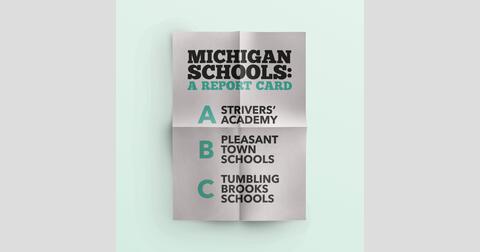Michigan Parents Deserve a Statewide Report Card for Schools
Informed parents make better educational choices. That’s why Michigan needs a clearer, more consistent and more meaningful system to report schools’ relative academic success.
In recent years, the Mackinac Center has been at the vanguard of highlighting the defects in Michigan’s current approach to grading schools. By leaning heavily on raw achievement scores, the state’s flawed Top-to-Bottom School Rankings essentially serve as a proxy for wealth and privilege. For schools, a strong and statistically significant relationship exists between a student body with a high percentage of low-income students and a low placement on the rankings.
That means some schools may face sanctions because they serve too many poor kids rather than because they have not helped their students make progress in the classroom.
Earlier this year the Mackinac Center released the second edition of the Elementary and Middle School Context and Performance Report Card. (Two high school analyses have been published in previous years.) Our formula, which uses several years of data from the state, takes into account the number of students who qualify for federal free-lunch assistance. The result is a “CAP Score” that measures a school’s achievement compared to what might be expected based on how many of its students live in poverty.
That’s why a pair of Detroit charter schools that sit in the middle or low end of the state’s school ranking — Martin Luther King Jr. Education Center Academy and Ross-Hill Academy — rose to the top of our latest report card. CAP Scores also help to separate the truly high-performing suburban and rural schools from those that are getting by based on enrolling a more privileged student body.
Our Context and Performance Report Cards provide a blueprint for the state to make immediate revisions to its school rating system. CAP Scores are a considerably better approach, given the currently available data. Further enhancements could create a system that helps observers distinguish school quality even more effectively.
The ongoing challenge is to promote high standards without discouraging schools from taking on students who need serious remedial help after languishing elsewhere in the system. Following Florida’s lead, other states have developed ways to measure the year-to-year learning progress of individual students — including a schoolwide student average and subgroups of students. Academic growth targets could be used to compare how well different schools help students who have fallen behind catch up. They can also help proficient students stay on track or accelerate their learning.
Michigan’s biggest obstacle to creating a more viable and meaningful school grading system is that it regularly changes the tests it gives to students. MEAP became M-STEP, which has been revised and now faces legislative scrutiny and may be replaced.
The state shouldn’t necessarily remain locked into the same assessment regime if a rigorous, less intrusive replacement can be found. But making the apples-to-apples comparisons that allow for accurate measures of academic progress — such as the Student Growth Percentiles that the Michigan Department of Education plans to incorporate into school accountability — requires some degree of consistency.
The need for consistency raises questions about how the Michigan Senate’s A-to-F grading system proposed for Detroit Public Schools would work. On paper, it would make more sense than the state’s existing framework. Student pass rates on state tests would be balanced against academic growth measures, at least when those comparisons can be made. Meanwhile, the Senate would give a combined but smaller weight to nonacademic measures, like student attendance, parent participation, and re-enrollment rates.
Yet even after addressing those issues, the Senate plan would not be effective. The first problem is a conflict of interest. The proposed Detroit Education Commission, made up of mayoral appointees, would have the power both to craft the details of the grading system and to determine the fate of schools that are graded C or lower and wish to expand. The commission could bolster its own power and limit competition from charters by setting the bar high enough that few or no charter schools could earn an A or B.
Second, the system would be layered atop the state’s existing rankings, a recipe for confusion among Detroit school operators. The Michigan School Reform Office would have to add a second grading system to its responsibilities but it would have no new incentive to begin closing perpetually failing district schools.
Any grading system sound enough to accurately measure the output of Detroit schools should be applied statewide. After all, parents who wish to use Schools of Choice have the right to make informed decisions as they consider educational opportunities across district lines.
Parents need a report card that is not only accurate but also easy to understand. Such a report should also give them a way to look at the underlying data. Louisiana and Ohio already excel in presenting school information effectively to parents and taxpayers.
The idea of a statewide report card is not new to Michigan policymakers. House Bill 5112, a 2013 measure to create a meaningful statewide A-to-F school grading system, passed out of committee but never made it to the Senate chamber. The time is ripe to press this discussion again.
Collecting and transparently reporting data to give a real and meaningful picture of school performance should be one of the Michigan Department of Education’s essential jobs. It may take years to have all the pieces required in an ideal system. But we can start making improvements today.
Michigan Capitol Confidential is the news source produced by the Mackinac Center for Public Policy. Michigan Capitol Confidential reports with a free-market news perspective.

